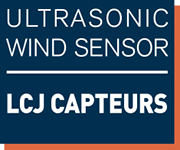Sound (and ultrasound) is conveyed by the movement of the fluid that it passes through. The electro acoustic transducers communicate with each other, two by two, using ultrasonic signals following the orthogonal axes to determine the wave transit time differences induced by the air flow. The measurements are combined in an integrated calculation to establish the wind speed and its direction in relation to a reference axis.
Temperature measurements are used for calibration corrections. The shape with inclination partially corrects the tilt angle effect of the sensor against wind module.
For the CV7 range sensors, transducers communicate laterally, which results in four independent measures. The validity checks are then reinforced and vectors measured windward are prioritised for wind speed and direction calculations. This method provides wind speed sensitivity of 0.13 m/s (0,25 knots), and 40 m/s. (80 knots) dynamic, and excellent linearity.
